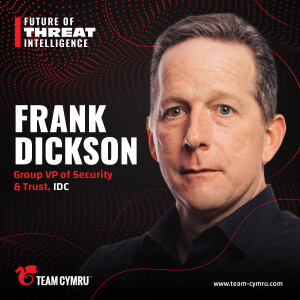
Thursday Feb 20, 2025
IDC's Frank Dickson on Moving from Reactive to Proactive Security Strategy
What happens when you combine market research expertise with cybersecurity strategy? On this episode of The Future of Threat Intelligence, Frank Dickson, Group VP of Security & Trust at IDC, shares his journey from market research to leading a team of 20 cybersecurity analysts advising organizations on security strategy.
Frank walks David through the industry's shift from reactive security to proactive threat management, discussing why traditional metrics need to evolve and how security leaders can better communicate risk to business stakeholders. His unique perspective on the CISO role's evolution, the impact of organizational complexity on security, and the strategic importance of data management reveals why technical expertise alone isn't enough for modern security leadership.
Topics discussed:
- Moving from reactive security to proactive threat management through strategic metrics and improved risk communication approaches.
- The evolution of the CISO role from technical expert to business leader, including critical communication and customer service skills.
- Impact of organizational complexity on security effectiveness, particularly in environments with legacy systems and acquisitions.
- Strategic approaches to managing and leveraging threat intelligence data while avoiding unnecessary complexity and redundancy.
- Balancing necessary and unnecessary risks when implementing AI and machine learning in security programs.
- Importance of translating cyber risk into business risk for effective communication with executives and board members.
- The evolution of security leadership reporting structures in response to changing business technology dynamics.
- Building strategic security programs that focus on simplification and clear business alignment.
- The challenges of regulation in driving security adoption while maintaining agility and effectiveness.
- Developing security metrics that meaningfully communicate value and risk to business stakeholders.
Key Takeaways:
- Implement mean time to detection and mean time to remediation as core metrics to measure security program effectiveness and efficiency.
- Transform threat data into actionable intelligence by aligning it specifically with your environment's outcomes and requirements.
- Streamline security infrastructure by consolidating tools and platforms to reduce complexity and improve manageability.
- Establish direct CISO-to-CEO reporting structures to effectively manage security across line-of-business technology initiatives.
- Develop customer service capabilities within security leadership to support sales processes and stakeholder relationships.
- Structure security communications around business risk rather than technical metrics to improve executive understanding and support.
- Create standardized taxonomies using frameworks like MITRE ATT&CK and OCSF to make security data more homogeneous and actionable.
- Evaluate AI implementation risks by distinguishing between necessary innovation risks and unnecessary implementation risks.
- Build security leadership skills progressively through compliance, business acumen, and executive communication capabilities.
- Maintain comprehensive data inventories to prevent orphaned data and reduce unnecessary security exposure.
Join us for a milestone celebration as RISE marks its 15th year of bringing together elite cybersecurity professionals, law enforcement, and enterprise teams.
Apply now to be part of RISE USA 2025 April 8 - 9th in San Francisco: https://www.team-cymru.com/rise-usa. Space is limited.
No comments yet. Be the first to say something!